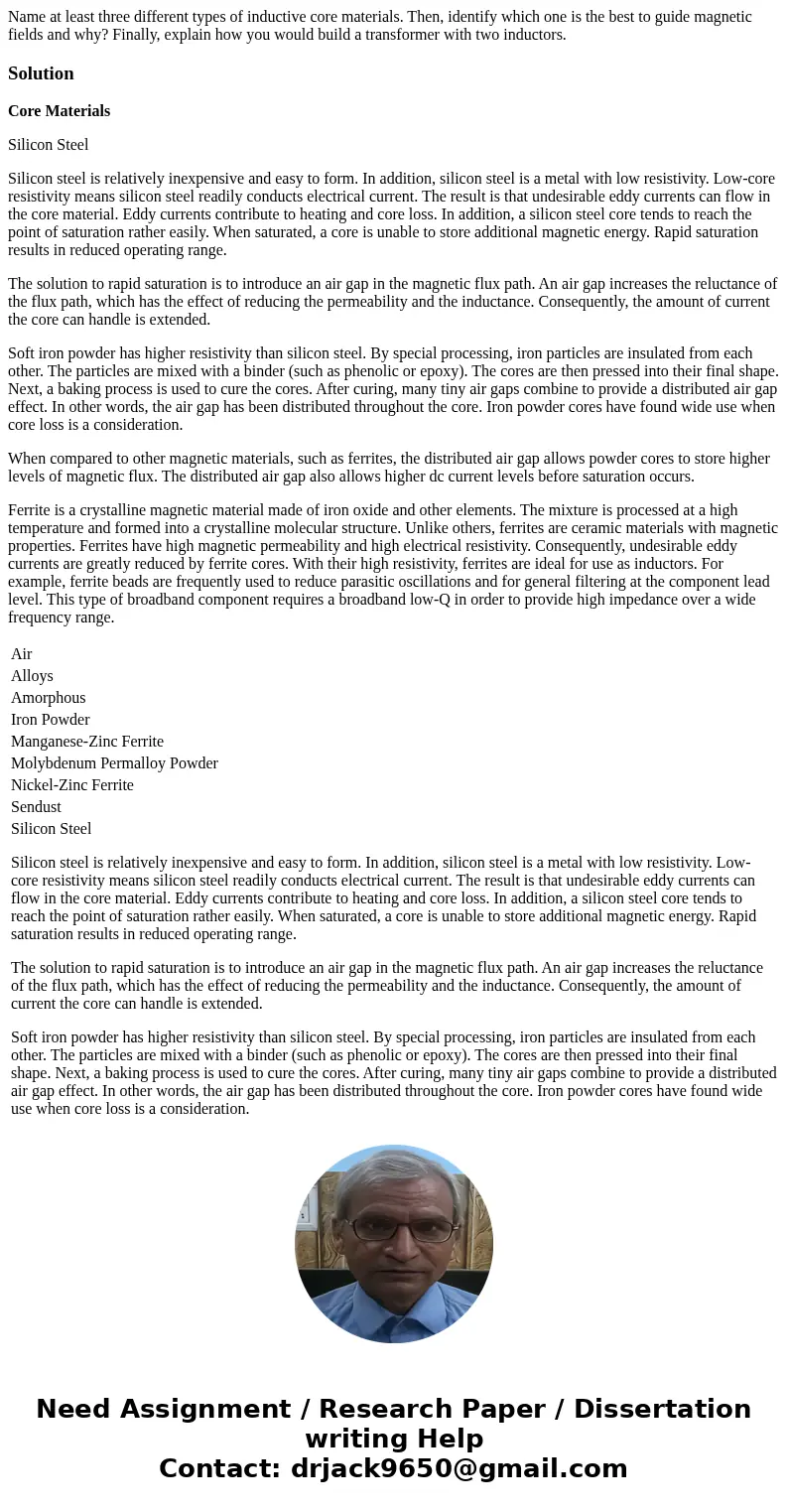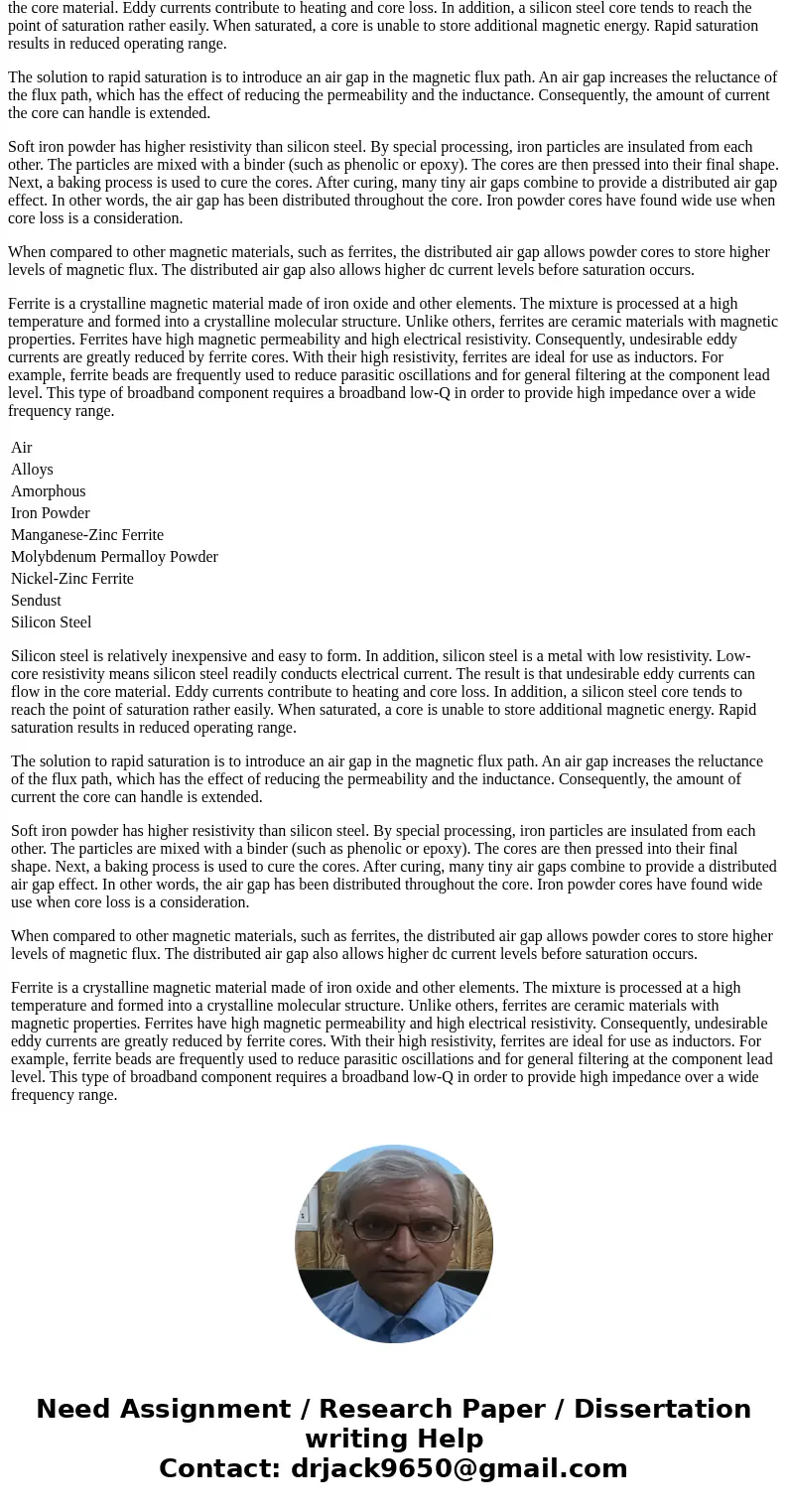Name at least three different types of inductive core materi
Name at least three different types of inductive core materials. Then, identify which one is the best to guide magnetic fields and why? Finally, explain how you would build a transformer with two inductors.
Solution
Core Materials
Silicon Steel
Silicon steel is relatively inexpensive and easy to form. In addition, silicon steel is a metal with low resistivity. Low-core resistivity means silicon steel readily conducts electrical current. The result is that undesirable eddy currents can flow in the core material. Eddy currents contribute to heating and core loss. In addition, a silicon steel core tends to reach the point of saturation rather easily. When saturated, a core is unable to store additional magnetic energy. Rapid saturation results in reduced operating range.
The solution to rapid saturation is to introduce an air gap in the magnetic flux path. An air gap increases the reluctance of the flux path, which has the effect of reducing the permeability and the inductance. Consequently, the amount of current the core can handle is extended.
Soft iron powder has higher resistivity than silicon steel. By special processing, iron particles are insulated from each other. The particles are mixed with a binder (such as phenolic or epoxy). The cores are then pressed into their final shape. Next, a baking process is used to cure the cores. After curing, many tiny air gaps combine to provide a distributed air gap effect. In other words, the air gap has been distributed throughout the core. Iron powder cores have found wide use when core loss is a consideration.
When compared to other magnetic materials, such as ferrites, the distributed air gap allows powder cores to store higher levels of magnetic flux. The distributed air gap also allows higher dc current levels before saturation occurs.
Ferrite is a crystalline magnetic material made of iron oxide and other elements. The mixture is processed at a high temperature and formed into a crystalline molecular structure. Unlike others, ferrites are ceramic materials with magnetic properties. Ferrites have high magnetic permeability and high electrical resistivity. Consequently, undesirable eddy currents are greatly reduced by ferrite cores. With their high resistivity, ferrites are ideal for use as inductors. For example, ferrite beads are frequently used to reduce parasitic oscillations and for general filtering at the component lead level. This type of broadband component requires a broadband low-Q in order to provide high impedance over a wide frequency range.
| Air |
| Alloys |
| Amorphous |
| Iron Powder |
| Manganese-Zinc Ferrite |
| Molybdenum Permalloy Powder |
| Nickel-Zinc Ferrite |
| Sendust |
| Silicon Steel Silicon steel is relatively inexpensive and easy to form. In addition, silicon steel is a metal with low resistivity. Low-core resistivity means silicon steel readily conducts electrical current. The result is that undesirable eddy currents can flow in the core material. Eddy currents contribute to heating and core loss. In addition, a silicon steel core tends to reach the point of saturation rather easily. When saturated, a core is unable to store additional magnetic energy. Rapid saturation results in reduced operating range. The solution to rapid saturation is to introduce an air gap in the magnetic flux path. An air gap increases the reluctance of the flux path, which has the effect of reducing the permeability and the inductance. Consequently, the amount of current the core can handle is extended. Soft iron powder has higher resistivity than silicon steel. By special processing, iron particles are insulated from each other. The particles are mixed with a binder (such as phenolic or epoxy). The cores are then pressed into their final shape. Next, a baking process is used to cure the cores. After curing, many tiny air gaps combine to provide a distributed air gap effect. In other words, the air gap has been distributed throughout the core. Iron powder cores have found wide use when core loss is a consideration. When compared to other magnetic materials, such as ferrites, the distributed air gap allows powder cores to store higher levels of magnetic flux. The distributed air gap also allows higher dc current levels before saturation occurs. Ferrite is a crystalline magnetic material made of iron oxide and other elements. The mixture is processed at a high temperature and formed into a crystalline molecular structure. Unlike others, ferrites are ceramic materials with magnetic properties. Ferrites have high magnetic permeability and high electrical resistivity. Consequently, undesirable eddy currents are greatly reduced by ferrite cores. With their high resistivity, ferrites are ideal for use as inductors. For example, ferrite beads are frequently used to reduce parasitic oscillations and for general filtering at the component lead level. This type of broadband component requires a broadband low-Q in order to provide high impedance over a wide frequency range. |


 Homework Sourse
Homework Sourse